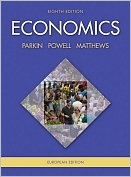| |||||
• polskie
• Zamów informacje o nowościach z wybranego tematu • kontakt |
ECONOMICS EUROPEAN EDITION WITH MYECONLAB ACCESS CARDPARKIN M. POWELL M. MATTHEWS K.wydawnictwo: PEARSON, 2011, wydanie VIIIcena netto: Economics touches almost every aspect of life, from climate change to terrorism, taxes to house prices, wages, to how much time to spend studying. Learning to think like an economist will enable students to evaluate economic policies, understand human behaviour, and make more informed decisions. This comprehensive text provides detailed presentation of the principles of economics, using real-world examples and applications. The aftermath of the global financial crisis is covered in depth, and its implications for future economic policy are thoroughly examined. With a wealth of in-text problems and applications, this text is also supported by MyEconLab. What is MyEconLab? A powerful online tutorial and assessment solution that includes comprehensive
homework, quiz, test, and tutorial options, where instructors can manage all assessment
needs in one program. This flexible system can also be used by students for self study
with the unique 'Personalised Study Plan' feature which helps them to identify areas of
weakness for further study and revision.
With over 240,000 registered students in 2010 doing 4 million assignments,
MyEconLab is the most effective and reliable online learning solution available for
economics today. Table of Contents Part 1: The Scope of Economics Chapter 1 What Is Economics? Part 2: How Markets Work Chapter 3 Demand and Supply Part 4: Coping with Market Failure Chapter 15 Public Choices and Public Goods Part 5: Factor Markets, Inequality and Uncertainty Part 6: Monitoring Macroeconomic Performance Chapter 20 Measuring GDP and Economic Growth Part 7: Macroeconomic Trends Chapter 22 Economic Growth Part 8: Macroeconomic Fluctuations Chapter 26 Aggregate Supply and Aggregate Demand Chapter 29 Fiscal Policy Glossary Book with access code
Po otrzymaniu zamówienia poinformujemy pocztą e-mail lub telefonicznie, |


